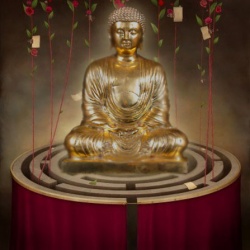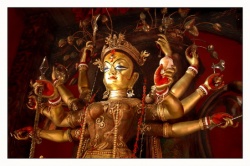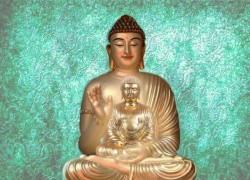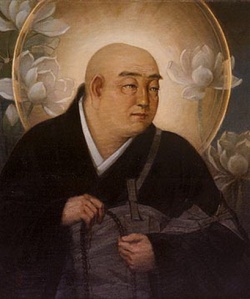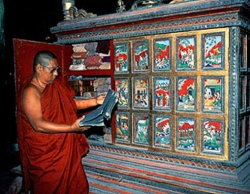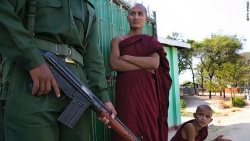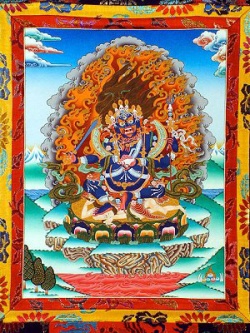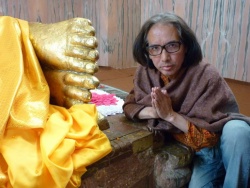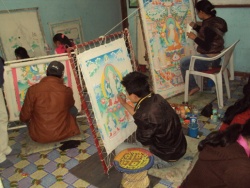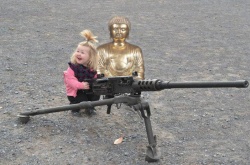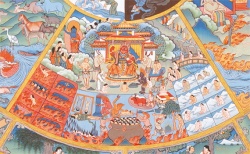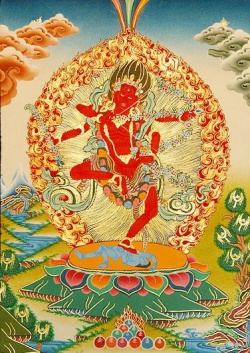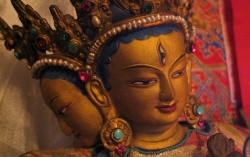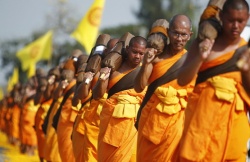Stupa or Chorten
The Buddha's Presence
Ven. Thrangu Rinpoche says that "Even though no living master may be present to teach the Dharma in actuality, generation after generation, people continue to see the stupa with their eyes, receive blessings, understand that there are the Three Jewels in which you can place your trust, and in this way, naturally, the Dharma continues.
In the same way, when building a stupa for the remains of a great master, his power and blessings will remain.
That is the reason to build a stupa. "
Also, in response to a student's question as to how to deal with so much suffering in the world, Thrangu Rinpoche recently responded, "Build peace pagodas (stupas) as they did in Japan, during the time of Nichiren.
His building of so many peace pagodas around the country led to (conditions for] peace and prosperity in Japan."
Stupas range in size from miniatures meant to be put on a shrine as reliquary and/or a remembrance of the mind of the Buddha, to enormous buildings that serve as temples as well as monuments.
Meaning of the Terms
Stupa is actually Sanskrit for "pile" as in a heap that gradually accumulates when each visitor to a grave leaves a small stone as a momento or calling-card.
All over the ancient world we find that the tombs of great individuals were covered in stones so that a tel, hill or cairn is eventually the result. The erecting of a ready-made cairn is certainly a related practice.
The Sanskrit word stupa is also used to designate a topknot, such as is created when all one's hair is gathered at the crown of the head.
In regions that are or were Buddhist, the word stupa (or in Tibetan, chorten) is sometimes used for a chaitya [Skt. sanctuary.
A chaitya is, in fact, an enclosure -- a building with a stupa inside it, so that people can be protected from the weather.
Chedi is the Pali term. Sometimes the word tope is found in older English texts.
A pagoda refers to the same type of monument.
The word is actually a 17th C. European corruption of dagoba, the Sinhalese (or, Sri Lankan) word derived from Skt. dhatu-garbha meaning repository.
It is usually takes the form of a stepped tower, but serves the same purpose.
Stupa usually signifies a domed memorial that normally contains relics and offerings.
Its shape evokes the seated figure of the Buddha, and there are 8 traditional variations to the form, each commemorating an event in the life of the Teacher.
They are evocative of the eight chaityas that first held the Master's relics.
The Eight Types of stupas
Each of the eight kinds of stupas commemorates an important event in Buddha's lifetime:
1. Stupa of Enlightenment (Skt. abhisambuddha bodhi mahacaitya) Tib. mngon par sans rgyas byang chub mchod rten che,
2. Stupa of many auspicious doors, bkra shis sgo mang sku bltams mchod rten che
3. Commemorates victory over Mara, byang chub snying por bdud btul mchod rten che
4. Evokes the lotus heap, theg gsum chos 'khor pad spungs mchod rten che
5. Reminder of miracles gratifying gods and men, lha mi'i yid tshim cho 'phrul bstan mchod rten che
6. Commemorates Buddha's descent from Tushita, ston mchog dga' ldan lha las babs mchod rten che
7. Marks the victory over all misadventures, nye zho kun las rnam rgyal mchod rten che
8. Commemorates appeasing of existence and nirvana, srid zhir mi gnas myang 'das mchod rten che
Barua's 1926 article Stuupa and Tomb.
Stupas and pagodas may be found either indoors or outside on open ground where the monument also serves as a landmark.
" . . . the oldest caityas were four in number.
These were located respectively at Buddha's birthplace (jati) (Lumbini), the place where he attained abhisambodhi (Gaya), the place where he made his first predication (dharmacakra-pravartana) (Vara.nasi) and the place where he attained nirva.na (Ku'sinagara).
It is not improbable that the first three caityas were founded before the parinirva.na took place and that is why Harsa in his poem (text IV) mentions these three as the first caityas . . . .
We know from the Divyavadana (389) that A'soka made a pilgrimage to Buddhist sacred places and established stupas.
But his teacher Upagupta while showing him round at Lumbini says . . . "this is the first caitya of Buddha, the best seer." ~ Bagchi.
The Eight Great Chaityas and Their Cult.
T. W. Rhys Davids wrote (1901): "The oldest authority, the Maha-parinibbana suttanta, which can be dated approximately in the fifth century B.C.[E.], states that after the cremation of the Buddha's body at Kusinara, the fragments that remained were divided into eight portions. . . . allotted as follows:
1. To Ajatasattu, king of Magadha.
2. To the Licchavis of Vesali.
3. To the Sakyas of Kapilavastu.
4. To the Bulis of Allakappa.
5. To the Koliyas of Ramagama.
6. To the brahmin of Vethadipa.
7. To the Mallas of Pava.
8. To the Mallas of Kusinara.
Though the stupa began as a simple pile of stones, it developed into a complex of symbolism.
These shrines are common in most Buddhist cultures often forming part of architectural mandalas such as the Khmer medieval site that is Ankhor Wat, and Java's Borobudur.
Today they are also present in the Americas, Europe, the Antipodes and elsewhere.
Of the 8 distinct types of stupa, see a Vijaya or Namgyal stupa.
Nitin's article at Exotic Indian Arts.
Damekh stupa at Sarnath in India.
Amaravati stupa, South India.
16th Karmapa's stupa at Rumtek with celestial ladder.
Karma Thegsum Tashi Choling, re: Tashi Gomang stupa of HH 16th Karmapa.
Interior of a stupa
This is the base of the Third Jamgon Kongtrul's memorial stupa in Pullahari, Nepal.
We see the offerings in the base, and the shrine set up as it was immediately after the offering ritual.
They are placed about the life-tree (sog shig) the central wooden pole that is at the core of the stupa.
At top left, we can see the green skin of a drum.
Here the chorten itself functions as the highest level of a typical Tibetan Buddhist prayer shrine, the two lower levels of which have been set out on the cloth on the cement foundation at foreground's centre.
At the rear, we see the ladder leaning against the base so that offerings can be placed inside.
At the right, in the background, someone on a scaffold is painting a mural.
3rd Jamgon Kongtrul's chorten at its dedication.This is the stupa at its official installation.
It has been covered in gold leaf and encrusted with turquoises, corals, amber and other jewels.
There is a window in gao or amulet-box shape at the third level below the 13-level spire with its lotus crown.
The location of this chorten is the Jamgon Kongtrul labrang at Pullahari, Kathmandu Valley, Nepal.
Examples of the 8 kinds of stupa are also at Pullahari, which is the home of the Rigpe Dorje Institute as well.
Building a Stupa
It is not advisable to try this without someone who is knowledgeable about the proportions, orientation and consecration of the stupa.
According to Lama Tashi Dondup, if any detail is incorrect or incomplete, obstacles are certain to arise.
That is, the project will not benefit you or any other beings and in fact, it could do more harm than good.
The reason may be that the stupa, like any other form of a buddha, should be perfect.
It is a reflection of the Ideal, and it serves a precise purpose.
It must be consecrated to this purpose that lends it to contemplation, in an extensive ritual invoking the blessing and protection of all classes of beings.
Lama Tashi Dondup is one of the few acknowledged specialists in matters relating to the visual supports used for Tibetan Buddhist practice, from tormas to tangkas, mandalas and stupas.
He was the consultant and manager for the erection of the 16th Karmapa's stupa in Crestone, Colorado, among others.
Following the request of the 17th Karmapa, his centre, Karma Tekchen Zabsal Ling, is now at more accessible quarters in the town of Aurora, Ontario.
It is on top of a small hill on 5 acres of land at the northwest corner of Bloomington Road and Leslie Street. (One block north of the previous location.)
As part of a project to help fund the move, a few cement stupas were especially built that conform completely to traditional requirements and yet are suited to North American conditions and lifestyle.
In the photo, such a stupa is installed on top of a base that is about 20 inches high, so that it stands at about 6 feet in all. This one is fully consecrated and contains more than 80 sacred relics, some that date back more than a thousand years!
Let us clarify: One does not go out and purchase a stupa of this nature.
This stupa was offered as a token for support of the dharma projects of Lama Tashi.
Since a stupa is erected to benefit beings, there are certain requirements concerning the nature of the site. It must be clean, dignified and well-protected.
It would be best if it were accessible to visitors, if only on a limited basis. That is because, once consecrated, it will contain many precious, sacred relics .
Note also, that the cost of transportation of the four heavy components comprising the stupa, as well as that of the people and their lodging (if you choose the option of having it filled and consecrated,) cannot be covered by this donation to Dharma.
A base, such as in the photo, consisting of cement blocks or about a 160 landscaping "bricks" (mortar is not essential) might also be an additional expense.
For further inquiry, please contact Lama Tashi via the Karma Tekchen Zabsal Ling web site.
Chatral Rinpoche, on the benefits of a stupa.
The Immeasurable Benefits of Stupas: A talk by Ven. Thupten Rinpoche at the Dhargyey Buddhist Centre, in NZ, 5 May 1996.
Great Stupa of Universal Compassion in Bendigo, Australia cf. Gyantse Kumbum.
History of the Little White Stupa in The Philippines.
Stupa of Tara Mandala and its sacred relics.
Circumambulation
Pilgrims and travelers circumambulate stupas as a form of respect and devotion.
Movement along the circular path (Tib. kora) is clockwise, so that the right shoulder is always facing the monument.
At Pullahari, the khenpo said that the dogs are in the habit of doing kora in the evenings.
When we arrive at the stupa, we pause, then contemplate and bow in recognition that it is the representation of the Buddha.
Some people like to pick up a handful of small stones so they can keep track of the number of their turns.
They can deposit one on a ledge after each turn.
We walk clockwise slowly and mindfully.
We can murmur the mantra of Buddha Shakyamuni while walking.
In the Kagyu tradition it is: OM, MUNI MUNI MAHAMUNIYE, SOHA
If you can do so, it is thoughtful to leave a small offering on a ledge or in a dish to help with the maintenance of the stupa.
The Vanishing Chorten of Tibet
Vijay Kranti writing to The Organiser (Sept. 15, 2002) had this to say about chortens in today's Tibet:
"The landscape and house architecture in the Tsang region of Tibet, housing cities like Shigatse, Gyantse and Tingri, remarkably resembles India's Ladakh region in Jammu & Kashmir state.
The only element that helps one in knowing whether one is in Tibet or Ladakh is the total absence of Chorten (Stupa) from the Tibetan countryside.
Though almost all stupas were destroyed during fateful days of Cultural Revolution the two giant stupas guarding the front of Potala are among those handful ones that appear to be preserved by the Chinese masters.
However, the strategic placing of these two stupas is enough to explain how much respect Beijing masters hold for their Tibetan subjects and their religion. In Tibet it is considered to be sinful and inauspicious to cross a stupa from the anti-clockwise direction.
But the two holy structures have been positioned in the middle of the majestic 'Beijing Road' in such a manner that every vehicle must cross them the wrong way.
No wonder you see old Tibetans closing their eyes and raising folded hands in prayer when their bus or rickshaw crosses each stupa from the wrong side."
The mandala that is the location of the great stupa at Boudhanath was built by Manadeva (464 - 505 CE). Tibetans call it Zyarung Khashor. In Nepali, the stupa is Khasti Chaitya.
It is one of the world's oldest and consequently, a UNESCO world heritage site.
